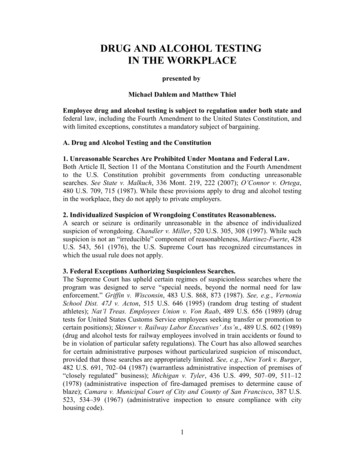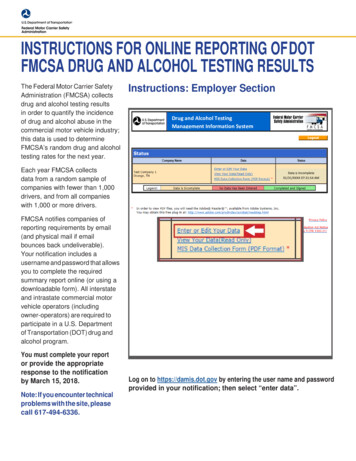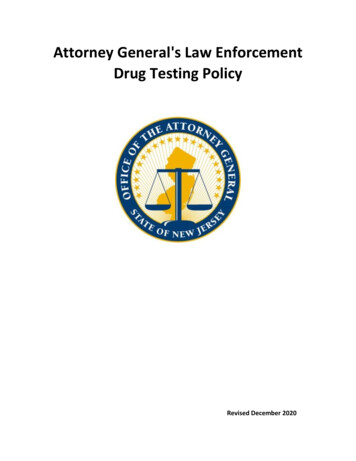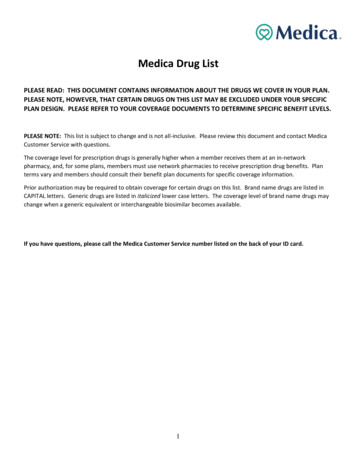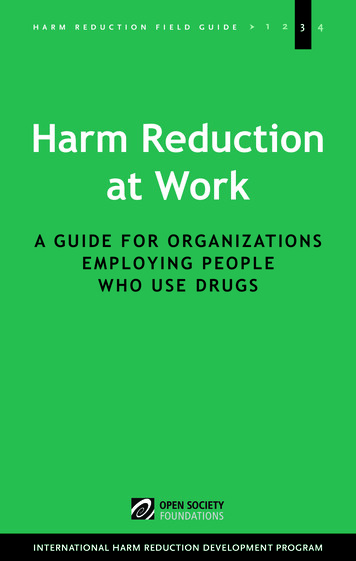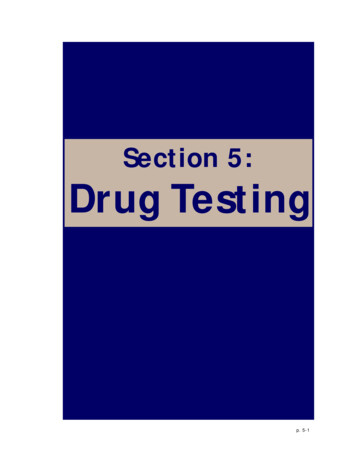
Transcription
Section 5:Drug Testingp. 5-1
Objectives1. To know the requirements of USMC drug testing policy and be able to advisethe CO to ensure that he or she is in compliance.2. To be able to explain the purpose of drug testing.3. To know the premise codes that can be used for drug testing, their properuses, and their limitations.4. To understand the roles of COs, SACOs, UPCs, and observers in conductingdrug testing.5. To be able to explain the qualities to look for in choosing UPCs and observers.6. To learn how to prepare for drug testing.7. To be able to demonstrate proper urine collection procedures.8. To know how to correctly complete drug testing paperwork.9. To know how to prepare urine specimens for shipping.10. To describe how to maintain the chain of custody for urine specimens.11. To be able to explain the basic drug testing laboratory procedures.12. To understand the special requirements associated with testing for drugsother than those that are routinely tested for.13. To understand how test results are retrieved.14. To know the appropriate steps to take if a test is positive.15. To be aware of common errors or discrepancies that occur in urine testing,and how to avoid them through quality control procedures.Purpose of Drug TestingMany Marines think the main purpose of the random drug testing program is tocatch drug users. This is not true. The primary purpose of random drug testingis to prevent illegal drug use among service members. Simply put, Marines areless likely to use illegal substances if they think they will be caught.Drug Testingp. 5-3
Random drug testing is a form of prevention and the evidence suggests that it isa highly effective one. Since the DoD began doing systematic randomdrug testing in the early 1980s, the estimated rate of illegal drug usewithin the military has dropped from 28% to less than 3%.The secondary goal of drug testing is to identify Marines who use illegal substances so they can be treated and separated from service. This is important because drug users often can’t pull their own weight. By using drugs, they put other unit members at risk. Early identification of Marines who use drugs allowsthem to get treatment before they harm themselves or others.Drug Testing PolicyMarine Corps drug testing policy states that:- All Marines, regardless of rank, must be screened for drugs annually.- At least 10% of each unit will be randomly tested monthly.- Regardless of when they were most recently tested.- Regardless of rank.- Even while deployed.- All personnel will be tested within 72 hours of a PCS, UA, or leave exceeding5 days.- Reservists will be tested at scheduled annual trainings.- SACOs at recruiting commands and brig staff will be tested quarterly.- SACOs, UPCs, observers, and Marines assigned to the SACC will be testedmonthly.- Only COs and Medical Officers may order drug testing.Premise Codes for Drug TestingThere are 10 different reasons for drug testing. Each one is represented by a specific premise code. Every urine test conducted must be ordered by the CO orMO, and must be based on one of these premise codes. Premises fall into twogeneral categories: routine testing (4 types) and targeted testing (6 types). Thefollowing table lists the premise codes within each category.p. 5-4Drug Testing
Table 5.1 Urinalysis Premise Codes.Routine TestingPremise CodeIRIUOONOBasisRandom SelectionUnitService-Directed and Other Service-DirectedAccessionTargeted TestingPremise CodeVOPOCOAOMOROBasisMarine’s ConsentProbable CauseCommand-DirectedOfficial Safety, Mishap, Routine TestingRoutine testing is conducted when there is no particular reason to suspect druguse. The four premise codes used for routine testing are described below.- IR (Random Selection). The majority of testing done at the unit levelwill be under the IR premise code. For an example of an IR test order see(example 5-1, p. 5-41). Per MCO 5300.17, at least 10% of each unit must betested monthly under this code.- IU (Unit). The IU premise code is used when an entire unit, sub-unit oridentified segment of a command is tested. The unit to be tested could beselected randomly or deliberately.- OO (Service-Directed and Other Service-Directed). The OO premisecode is used for testing specifically directed by the Secretary of the Navy(SECNAV) or the Commandant of the Marine Corps (CMC). This applies totesting personnel in several specific roles or at specific times: Monthly testing: Required for SACOs, Marines involved in the collec-tion and shipment of urine (UPCs and observers), and Marines assignedto SACC.Drug Testingp. 5-5
Quarterly testing: Required for SACOs at recruiting commands and brigstaff. Testing within 72 hours: Required of reservists at scheduled annualtrainings and all Marines reporting from a permanent change of station(PCS), unauthorized absence (UA), or leave longer than 5 days.- NO (Accession). Accession testing is used to test all personnel seekingaccession into the Marine Corps. These tests are carried out within 72hours of enlistment or appointment. This type of routine testing does notoccur at the unit level.NOTE: Testing carried out on any member of the urinalysis team (SACO, ASACO, UPC, observer) must beconducted by another collection team. The specimensmust also be shipped in boxes that do not contain anyurine that they themselves collected.Targeted TestingTargeted testing is done when the CO wishes to test a particular individual orgroup. The six premise codes that can be used to conduct targeted testing aredescribed below.- VO (Marine’s Consent). This code is used when an individual Marineconsents to a drug test. If a Marine is suspected of unlawful drug use, he orshe may be asked to consent to testing. It is essential that the Marine be advised by the command representative that he or she may decline to providea sample. Consent should be obtained in writing. See example 5-2, p. 5-42for a sample urinalysis consent letter.- PO (Probable Cause). Tests may be ordered under this code when thereis probable cause to believe that a member has committed a drug offenseand that a drug test will produce evidence of such an offense (per MilitaryRules of Evidence [MRE] 312(d) and 315). It is strongly recommendedthat you consult with the Staff Judge Advocate (SJA) before ordering a test under this premise code to make sure probablecause exists. Example 5-3, p. 5-43 provides an example of an order toconduct a PO test.p. 5-6Drug Testing
- CO (Command-Directed). A urine test may be ordered under this premise code at the commander’s will. Marine consent or sufficient probablecause are not required. A test under this code may be ordered to determinecompetency for duty or the need for counseling, rehabilitation, or othermedical treatment. Tests conducted under this code cannot serveas a basis for disciplinary action, only administrative action(e.g. processing for administrative separation) (see example 5-4,p. 5-45).- MO (Physician-Directed). The MO code applies to drug tests ordered bya military physician or medical officer. Under MRE 312, the medical officermay order drug tests in connection with a competence for duty examination. The medical officer may also order tests under this code when conducting a medical examination of a Marine referred by the command forsuspected drug abuse.- AO (Official Safety, Mishap, Accident). Tests ordered under the AOcode are part of a formal mishap or safety investigation.- RO (Rehabilitation/Treatment). The RO code is used to test participants in substance abuse counseling or rehabilitation programs. The purpose of the testing is to determine compliance with abstinence requirements.Drug Testing RolesSACOAs SACO you ensure that the unit drug testing program operates efficiently, fairly, and effectively. You may delegate some drug testing tasks to other teammembers, including the assistant SACO (ASACO), urinalysis program coordinator (UPC), and observers. However, you are still the one responsible for the program. You are responsible for ensuring that your unit is complying with all regulations relevant to substance use. It is up to you to make sure that the program isoperating properly and accomplishing its stated goals. More specifically, it isyour job to ensure that: All drug testing requirements are met. The drug testing program is conducted fairly, with honor and integrity. Members of your team are well-trained in policies and procedures.Drug Testingp. 5-7
Members of your team correctly and conscientiously follow procedures. Urine samples are not determined to be untestable by the lab due to discrep-ancies in how they were collected, handled, or shipped. Accurate and complete urine testing records are maintained. All records remain confidential.The effectiveness of your drug testing program will have a major impact on deterring drug use and ensuring unit readiness. Marines’ careers are in yourhands. Maintaining a strong and consistent drug-testing program will help youand members of your team (i.e., UPCs and observers) if and when you are required to testify in legal proceedings regarding substance-related violations.The SACO is personally responsible for the effectiveoperation of the unit’s urinalysis program.UPCsThe duties of UPCs are primarily administrative. UPCs can stand in for you orassist you with urine collection. Specifically, the UPC can: Prepare all materials and supplies for the testing session. Secure an appropriate site to conduct drug testing. Maintain control over the area. Maintain surveillance over all service members selected for collection. Coordinate observers and review proper procedure with them prior to eachurine collection session. Ensure proper completion of paperwork related to testing. Conduct quality control before delivering samples to the SACO for testing.To perform these duties, the UPC must be a conscientious and organized person.The job requires the UPC to have a serious demeanor and strict attention to detail.ObserversThe responsibility of observers is to watch the urine collection process. Specifically, the observer must:- Escort the member providing the sample to the head and back, keeping thebottle in clear view at ALL times.p. 5-8Drug Testing
- Be the same sex as the Marine observed.- Observe only one Marine at a time.- Have direct line of sight on the urine leaving the body and entering the bottle.- Sign the paperwork certifying he or she observed the subject Marine whilethe Marine provided the sample.- NEVER TOUCH THE SAMPLE AT ANY TIME.Astute observers are essential for catching any tampering, adulteration orswitching of urine. The position of an observer may be awkward or embarrassing. Maintaining a professional bearing will help ensure the comfort of the provider and the dignity of all participants.Medical OfficersThe MO will review results of all positive drug tests to determine whether theycould be explained by legitimate use of prescribed medication. The MO is theonly person besides the CO who can order drug testing.Commanding OfficersThe CO (or MO) must order all drug tests. The CO will review results of all positive drug tests (following the MO review) to determine whether unauthorizeddrug use occurred.Drug Demand Reduction CoordinatorsDDRCs will provide oversight of unit-level drug testing programs. DDRCs areresources who can assist with questions regarding drug testing policies and procedures.Drug Testingp. 5-9
Steps in Drug TestingDrug testing is a complex process with many steps. To ensure the integrity of theprocess and the accuracy of results, it is important that these steps are followedexactly. The table below lists the main steps that must occur before, during, andafter urine collection.Table 5.2 Steps in Drug Testing.BeforeDuringAfterGroundwork Assist CO in selectingUPCs and observers. Train UPCs and observers. Maintain supplies.Conducting Testing Re-brief UPCs andobservers. Notify Marines. Bring supplies. Secure testing area. Collect urine samples. Oversee UPCs andobservers.SubmittingSpecimens Prepare and ship bottles. Maintain chain ofcustody. Preparing forTestingSchedule testing.Identify test site.Staff testing.Generate paperwork.Prepare materials.p. 5-10Results View test results anddiscrepancy codes. Obtain command determination (for positive tests). Maintain secure confidential records oftests and results.Drug Testing
Before: GroundworkSelection and Appointment of UPCs and ObserversUPCs and observers assist with urine testing. The more trained UPCs and observers you have, the easier it will be to schedule testing and the less time thesessions will take. A general rule is that you should have at least 2 UPCs and 2observers for every 100 people in your unit.Observers must be the same sex as the Marine they are observing. Therefore, ifthere are females in your unit, you will need at least 1 female observer. If this isnot possible, make arrangements with a female from another unit to serve as anobserver for your female unit members.UPCs and observers must be designated in writing by the CO. The CO may designate specific individuals or groups of individuals to serve in these roles. For anexample of this, see example 5-5, p. 5-47. Selected individuals should be rankedE4 or higher and should be upstanding members of the unit with no drug or alcohol related incidents within the past 2 years. Because observers are the mostlikely of anyone on the drug testing team to be required to testify in court, it isespecially helpful to have higher ranking personnel serving in this position.Choosing responsible and trustworthy Marines to serve in these roles is extremely important because there may be attempts to bribe the UPC or observer.Training UPCs and ObserversIt is highly recommended that UPCs and observers complete the drug testingsection of the SACO curriculum. If this is not possible, separate trainings can beprovided to them by the DDRC and/or the SACO. Although the duties primarilyfocus on the execution of drug testing, it is important that they understand thegoals of the program and the context in which drug testing occurs.If you will be asking UPCs to assist you with generating drug testing paperwork,they should also sit in on the portion of the SACO course that covers use of theDrug Testing Program (DTP) or DTP Lite (See Section 6: Computer Training, p.6-5).At the conclusion of their initial training, UPCs and observers will be asked toreview and sign a document indicating that they understand their responsibilities (examples 5-6 and 5-7, p. 5-48 and 5-49).Drug Testingp. 5-11
All trainings provided, including trainings of UPCs and observers, should be recorded in ADMITS (Section 6: Computer Training, p. 6-38).Maintaining Testing SuppliesIt is important that you always maintain a supply of testing materials. Most necessary supplies can be ordered using the supply system (see example 5-8, p. 550). As a general rule, have enough supplies to conduct two tests of each Marinein your unit.It may take time for supply orders to be filled, so plan ahead and make sure youhave plenty of supplies at all times. Having supplies on hand prevents you fromhaving to order them at the last minute. This could cue Marines in your unit thata drug testing session is about to occur.Always maintain enough supplies to test everymember of your unit twice.Before: Preparing for TestingScheduling TestingMCO 5300.17 requires that 10% of the unit be randomly drug-tested monthly,even in months when a unit sweep (IU) test is conducted. It is your duty to ensure that your unit is in compliance with USMC drug testing requirements. Youwill be working closely with the CO to plan and schedule drug tests. Only theCO or MO can order a test.Frequency of TestingBest practices require planning to conduct random testing of morethan the minimum requirement of 10% per month and conductingmultiple testing sessions each month. Rather than testing 10% of Marinesonce a month, consider testing 3-4% of Marines each week. This will help youavoid being out of compliance if something goes wrong with any single testingsession. It will also enhance the perception that testing is frequent and hard toavoid.p. 5-12Drug Testing
Predictability of TestingTo deter illegal drug use, testing must be thought of as unpredictable. Any patterns in the timing of testing will undermine its effectiveness. To make testingtruly random, you should: Vary the day of the week on which testing is done. Do not link testing to liberty. Avoid any behaviors that could tip off unit members that a test is about tooccur. Use DTP to be sure that personnel selected for random drug tests are selected randomly.Maintaining DocumentationThe CO should order all drug testing in writing. This may be done by memo, letter, or email. Testing orders should at minimum specify:- Testing date.- Number, percentage or identity of personnel to be tested.- Testing premise code.Examples of letters/memos to order testing under several different premisecodes are provided at the end of this section (see examples 5-1 through 5-4, p. 541 through 5-45 ).Retain documentation of all testing orders you receive in electronicand/or hard-copy form. These orders provide evidence that the test was ordered by the CO, as required by MCO 5300.17.Identifying Testing LocationThe SACO or UPC must identify an appropriate testing location. The testing location must have a waiting area and a head for actual sample collection. Theseshould be located near each other. Ideally, it will be an area that can be securedso that no one other than personnel involved in testing can enter during the testing session. Also, it is preferable to have only one door through which Marinesmay enter or exit during testing.The waiting area must have space for a table and chair for the UPC station, andenough waiting room space for the number of Marines scheduled to be tested.Ideally, there will be seating for all Marines waiting to be tested. It is very important that there is sufficient space that the UPC’s table can be physically separated from the waiting Marines. No more than one Marine should be at or nearDrug Testingp. 5-13
the UPC’s table at any given time. This is essential so that the UPC can maintaincontrol of all materials, paperwork and samples.The heads used for testing also need to be secured so that they are used only bypersonnel involved in drug testing during the time of the drug testing session.There may be separate heads for males and females, or a single head used byboth (although not at the same time). Heads used for drug testing must be structured so that adequate observation is possible. In larger heads, and when a largenumber of drug tests are being conducted, it is possible to have more than oneMarine providing samples at the same time. However, each Marine is requiredto be observed by his or her own observer, since an observer can only observeone Marine at a time. In addition, the observer must always be of the same gender as the Marine providing the urine sample.Staffing Drug Testing SessionsIt is your responsibility to ensure that each testing session is adequately staffed.At a minimum, you need one person to serve as UPC and one to serve as observer. You may be one of the people staffing the session, or you may rely upon yourASACOs, UPCs, and observers to conduct the session.If a large number of Marines will be tested, the session will go more quickly andsmoothly if you schedule multiple UPCs and observers. Recall that you will needto have at least one female observer if female Marines will be tested.Whether or not you are physically present at drug testing sessions, it is your responsibility as SACO to ensure that all rules and requirements governing drugtesting are faithfully followed. This includes ensuring that all drug testing staffare properly trained, and that they understand their roles in the process.If you are not present at drug testing sessions, you should periodically stop bysessions to monitor how your drug testing staff are conducting sessions. If thereare weaknesses or gaps in their procedures, you are responsible for providingthem with constructive feedback so that they may correct them.Selecting Participants and Generating PaperworkYou or your designated representative — that is, your ASACO or UPC — will useeither the Drug Testing Program (DTP) or DTP Lite to select the unit membersfor drug testing. These programs allow you to specify individuals to be testedunder targeted testing or to select a random sample of unit members for randomp. 5-14Drug Testing
testing (Section 6: Computer Training, p. 6-1).These programs will also generate the paperwork needed for drug testing. Thisincludes:1.2.3.4.A list of the personnel to be tested (see examples 5-9a and 5-9b, p. 5-51).The testing register (see example 5-10, p. 5-53).DD Form 2624 (front and back; see examples 5-11a and 5-11b, p. 5-54).Bottle labels (see example 5-12, p. 5-56).You can use DTP or DTP Lite to generate the drug testing paperwork any timebetween when the CO orders a test and when the test is conducted. However, itis not advisable to wait until the last minute in case there is a problem with thecomputer, the program, or the printer.Preparing your drug testing paperwork ahead of timewill help the testing session go smoothly and stay onschedule.Preparing Specimen Bottles & Shipping ContainersYou or your ASACO or UPC will need to prepare the boxes that will be used toship samples to the drug testing lab. This should be done before the testing session. To do this:1. Determine how many samples you plan to collect. To prepare for asession, determine the number of specimen bottles that will be needed.2. Determine the number and size of shipping containers that youwill need to hold the collected samples. Bottles must be shipped in approved shipping containers, which come in different sizes to meet the needsof large and small drug testing sessions.3. Obtain shipping materials and specimen bottles from your storage facility. A supply of drug testing materials should always be on hand inyour storage location. Collect the necessary number and size of shipping containers, absorbent pads, small trash bags, and package sealing tape. Youshould bring more specimen bottles than you expect to need to the testingsession in case some bottles become damaged or contaminated.4. Make each shipping container leak-proof. Together, absorbent padsand small trash bags will be used to make each shipping container leakproof.Drug Testingp. 5-15
5. Insert the divider, creating aseparate compartment for eachspecimen bottle. Then, place anempty specimen bottle within eachcompartment.6. Your container should look likethe picture on the left. Your bottles and shipping cartons are nowready to be taken to the drug testingsession.During: Conducting TestingRe-Brief UPCs and ObserversBefore each session, you will need to review drug testing roles and procedureswith the UPCs and observers who will be assisting with the session. After briefing them, each one will need to sign a Urinalysis Brief Sheet (see example 5-13,p. 5-57).Notify Selected MarinesMarines who are selected to participate in a drug testing session will be listed onthe Personnel to be Tested form produced by DTP or DTP Lite (see example 59a, p. 5-51). Marines should be notified of the time and place of the testing session by email, phone call, or in person. The method should be chosen based onexpediency and efficiency. For your records, note on the Personnel to be Testedform if and why a Marine is unavailable for testing.Notification should occur no earlier than two hours before testing, and Marinesshould be given a short time window during which to appear at the session.p. 5-16Drug Testing
Bring Necessary SuppliesMake sure that you (or your designated UPC) bring everything needed to thetesting session. At a minimum, this will include: List of personnel to be tested (example 5-9a and 5-9b, p. 5-51). Testing register (example 5-10, p. 5-53). Prepared DD2624 forms (example 5-11a and 5-11b, p. 5-54). Bottle labels (example 5-12, p. 5-56). Red tamper-resistant tape for sealing bottles. Black ballpoint pens. Prepared shipping boxes, with absorbent pads and trash bag lining. Sample bottles (inside shipping boxes). Female urine transfer cups (if female Marines will be tested). Gloves for handling specimen bottles. Bottled drinking water (if water is not available at the testing site).Be prepared for possible problems by bringing more supplies than you anticipate needing. As a rule of thumb, bring at least 10 extra sample bottles, 3 extratransfer cups, 10 extra strips of red tamper-resistant tape, and 3 ballpoint pens.Securing Testing SiteStaff who will be conducting the testing session should arrive early to secure thesite and prepare for the session. Access and control barriers should be established if possible and unnecessary personnel should be removed from the area.Marines are NOT allowed to bring backpacks, water bottles, camelbaks, or anyother items into the room. They are not allowed to drink their own beverages atthe testing site. This is because these drinks may have substances in them thatare designed to affect their urine. Even the consumption of excessive amounts ofwater may be an attempt to dilute urine and prevent a positive test result. Youcan provide reasonable quantities of sealed bottled water to the Marines or theycan use a drinking fountain if one is available in the testing area.A Detailed Guide to the Testing ProcessIt is essential that you are VERY comfortable with all of the steps of the drugtesting process. Not only are you responsible for the program but you also willneed to train UPCs and observers and make sure they are properly followingprocedures.Drug Testingp. 5-17
After the Marines to be tested have arrived, they should be briefed on procedures:- Marines should not approach the table until directed to do so.- If they have any questions or issues while waiting, they should remain wherethey are and raise their hand.- Marines should never approach the UPC unless directed to do so.In a controlled area, the UPC will direct one Marine at a time to approach the UPCtable and present a military identification card. The UPC confirms the identity of theMarine.p. 5-18Drug Testing
The Marine removes an empty specimen bottle from the box. The Marine places his or her ID card in the empty slot from which the bottle was removed. Theidentification card is retained by the UPC during testing.The observer will watch the Marine select a bottle. This is the point at which theobserver will assume responsibility for monitoring the Marine and the specimen bottle.To prevent mix-ups, if multiple specimens are collected at the same time, have Marines take their bottlesfrom different areas of the box.Drug Testingp. 5-19
The Marine will visually inspect the bottle to ensure that there is no debrisinside. If the Marine does not approve of a bottle, he or she can choose a different bottle. In that case, the first bottle should be destroyed.The Marine should NOT put a finger inside the bottle or blow intothe bottle.If this happens, the bottle should be destroyed and another selected.p. 5-20Drug Testing
If the subject Marine is a female, the UPC will offer her the option of taking atransfer cup. Females have the option of urinating into this cup, and then transferring their urine from the cup into the standard specimen bottle. Just like with thespecimen bottle, the Marine should not put a finger in or blow into the transfercup. If she does, that transfer cup should be destroyed and another selected. Bothtransfer cups and specimen bottles must remain in full view of the observer at alltimes.After leaving the UPC table, the Marine will go to the head, holding the bottle upover his or her shoulder. The observer will follow closely behind, keeping the bottlein full view. If a Marine has a transfer cup, that should also be held within the observer’s view. The observer must never lose sight of the bottle (and transfer cup,if applicable).Drug Testingp. 5-21
Upon reaching the head, the observer will position him- or herself so as to beable to witness the complete collection process, to include at least 30 ml ofurine (or 60 ml for steroid testing). The observer must maintain full observation of the specimen bottle during this process and must directly observethe stream of urine leaving the body and entering the bottle. For males, thiswill typically occur at a urinal. For females, it will typically occur within abathroom stall (not pictured).The observer must be continually vigilant for any attempts at adulteration,dilution or substitution (described below).If the sample provider is female and using a transfer cup, the observer must observe the stream of urine leaving the body and entering the cup, as well as thetransfer of urine from the cup to the standard specimen bottle. The transfer cupcan then be discarded in the trash receptacle in the head. Throughout this process, the observer must be vigilant for any attempts at adulteration, dilution orsubstitution.p. 5-22Drug Testing
As the subject Marine returns the urine sample to the UPC, the Marine shouldagain hold the bottle up so that it is clearly visible to the observer at all times.The observer must NEVER lose sight of the bottle.At the UPC table, the observer will sign the urinalysis ledger and print his or hername to certify that the specimen bottle contains the subject Marine’s urine. Atthis time, the observer will also notify the UPC of any comments, attitudes orunusual actions taken by the Marine while under his or her observation. Anysuch actions will be noted in the “Comments and Disposition” field on the DrugTesting Program Testing Register.Drug Testingp. 5-23
The Mar
- Only COs and Medical Officers may order drug testing. Random drug testing is a form of prevention and the evidence suggests that it is a highly effective one. Since the DoD began doing systematic random drug testing in the early 1980s, the estimated rate of illegal drug use within the military has dropped from 28% to less than 3%.

